Discover how using keyword gap analysis help you to drive traffic to your website. Check out the five steps on how to conduct keyword gap analysis.
Use keyword gap analysis to help you uncover valuable keyword opportunities that you are missing out on.
Say you have written great content and hit the publish button. What’s next?
You log into your analytics to see the traffic. Chances are you’ll see something like the image below that shows you how many visitors are currently reading your content.

Well, most of the time reality tends to hit you hard in the face… but it actually does not have to be that bad. Let’s look at the statistics below.
It is reported that in March 2019 alone, over 4.4 million blog posts were published every day! That’s equivalent to 51 blog posts being published every second.
If you want your hard work to stand out from the rest, your efforts should not just revolve around writing “just another” blog post.
It may sound cliche to say this but you must be willing to put in extra work to see a positive return on your work. Yes, extra effort is needed here!
So, the question is – how do you get people to read your content?
Trust me, there are endless tactics and strategies out there to get people to read your content. Well, if you don’t believe me, try searching for “how to get people to read my content”. You’ll see a whopping 7.56 billion search results returned on Google!
You can simply pick any of the suggestions and implement them right away. But we all know it’s not as easy as it sounds when it comes to doing search engine optimization. Why? Because Google now uses more than 200 factors in their algorithm. The good thing is you don’t have to tick off all the 200 algorithm lists because it’s nearly impossible anyway!
Today, we will be looking at one of the core elements that get your content optimized for Google and humans; keyword gap analysis.
It is the one strategy that you should be using for your next great content.
Of course, I have implemented the strategy myself and have proven it to work! It is now my turn to share them with all of you.
Let’s start!
What is keyword gap analysis for SEO?
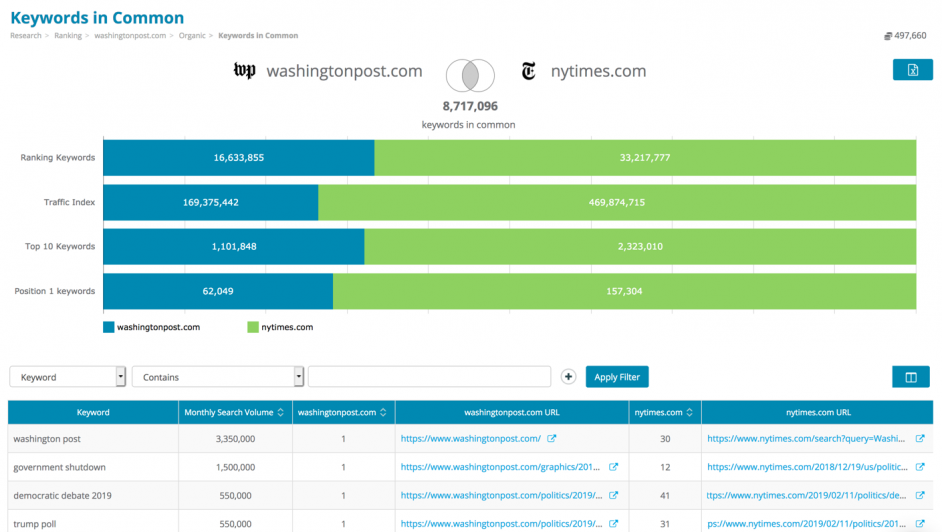
Keyword gap analysis is the process of analyzing your existing content and discovering the “gaps” between your keyword strategy and your competitors as well as uncovering areas of opportunity.
The main reason why we are looking at the keyword gap today is that it really does help our content to perform better. This is done by comparing what is lacking in your content when compared to competitors. Stay with me, I will be explaining more on this in a bit…
Let’s assume you have written a topic on “the benefits of exercising” for your fitness website.
- How do you make sure your targeted visitors are able to find you in the sea of content produced every single second?
- Is your content relevant to your customers?
- What are the keywords they are using to find you?
- What are the keywords your competitors are using?
I’m sure all these questions have lingered in your mind before as I did.
To be able to rank on the first page of the search engine result page is not depending on luck or magic. A major part of it comes from identifying the right keyword searchers used when doing a search.
Here comes the question – Have you ever wondered what keywords your competitors are using to tackle those searches but are not found in your content?
This is where the keyword gap comes in. You want to fill in the “gap” by using the right keywords to close the gap between your content and the searchers’ queries.
Why does the keyword gap analysis matter to you?
Because keyword gap analysis allows you to see where you are being outperformed, what you need to do next, and most importantly how you can outrank others.
Have you ever played a puzzle? Doing keyword gap is exactly the same as completing a puzzle. You find the missing pieces or “gaps” from the whole picture. Once you discover it, the picture will start to look a lot clearer. This is where optimization is done and getting better rankings will follow suit.
Here are the strategies you can use to get the most out of your keyword gap analysis.
How can you do a keyword gap analysis?
Filling in the “gap” should not be that hard right? I would say yes if you know what exactly is the gap that you are looking at…or if you have a keyword gap analysis tool like RankingGap to do the job for you.
Tools like RankingGap instantly capture all the keywords that you and your competitors are ranking for. This way, you get to uncover the gaps between you and your competitors easily in one dashboard.

But now, let me show you the five steps on how to conduct a keyword gap analysis first.
1. Expand your target keyword
Before writing your content, you must already have listed down a few keywords that you want to rank for.
Now, write them out on a piece of paper and expand them by including their most relevant related keywords.
It is pretty easy to find related keywords. Go to Keyword Intelligence and enter your target keyword.
For example, there are 120 related keywords found for ‘exercise benefit’.
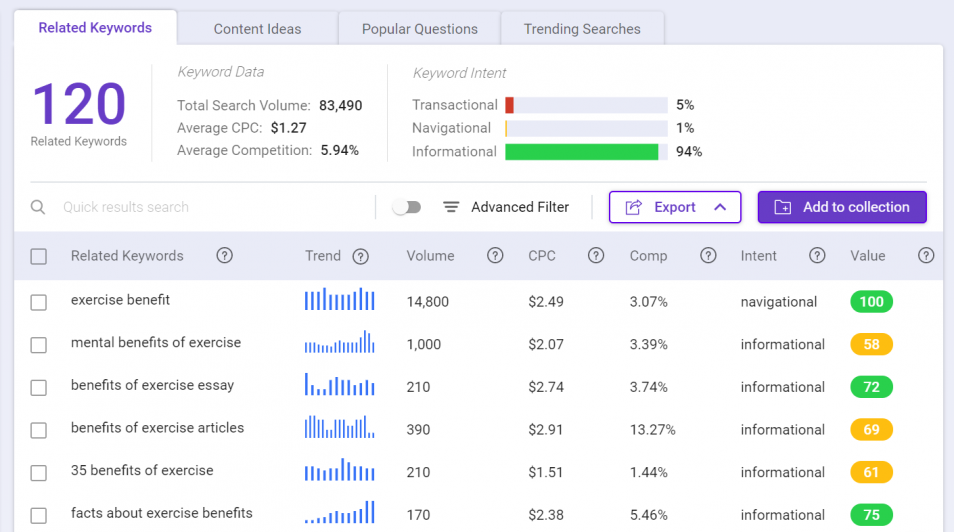
It can be quite confusing to decide which keywords to select. So, what we will do next is – sort the keyword by its ‘value’. A high-value keyword potentially gives you more traffic at a lower competition.

2. Identify your competitors
Knowing who your competitors are is a crucial part of doing your keyword gap analysis. In fact, it is the deciding factor for your keyword choices.
If you already know who you are competing with, you may skip this step and move on to the next step. But if you have not, do read on.
Then, type your target keyword into Google and write down the sites that show up on the first page.
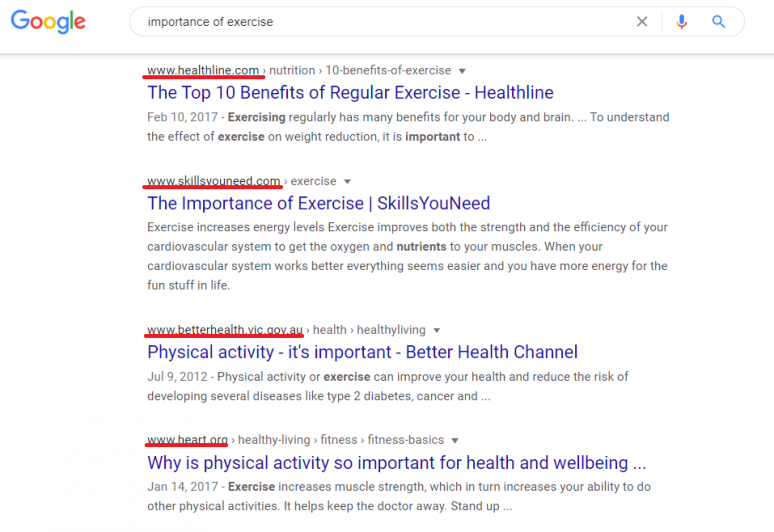
You may notice that some sites may appear more than once on the first page. This indicates a high authority for that particular topic.
When finding who your competitors are, it’s important that you find sites that are “truly” competitive with yours. Comparing “www.betterhealth.vic.gov.au”, or “www.heart.org” with your fitness site would not be a fair comparison. I would suggest you not include a large brand or site operated by the Public Interest Registry.
Basically, we are looking at a competitor that is performing slightly better than us, and that we are still able to catch them up. We don’t want to be aiming for keywords that we have no chance to rank at all.
3. Identify the missing keywords
Next, it is time to identify the keywords that your competitors rank for and don’t rank for.
To ease up this process, let’s look at the keyword gap tool you can use to identify the keywords that you should be looking at.
Use BiQ’s Rank Intelligence
To ease up this process, let’s use Rank Intelligence to quickly identify the keywords that your competitors already ranking for.
Simply add your competitor’s domain on the Rank Intelligence, and you will see this result:

In the ‘Summary’ tab, you will get to see their total ranking keywords together with their distribution.
Other than that, you can also view all the ranking keywords complete with their metrics.

Go through the list of your competitors’ ranking keywords and see which keywords are missing from yours. This would also be great to identify new content opportunities.
Head over to Rank Intelligence and let me know about your experience using it. I would love to hear them in the comments below.
4. Re-optimize your content
If you need a reason why re-optimizing your content is worth your time, the team from Hubspot has already done the research for you. They managed to find out that up to 76% of the traffic to a blog actually comes from old posts.

That means out of 100 visitors, 76 of them actually come from your old blog posts! Just imagine the difference it can give you if you were to re-optimize your old posts today. Needless to say, you will gain traction and start moving up the ranks too.
Now, that is exactly what we are going to do. After compiling your list of keywords from step 3, it’s time to re-optimize your content!
There’s a probability that your content was not fully optimized the first time it is published, and it is currently time to fix them. I’m pretty sure you’d have a list of keywords that others used to rank by now so you can apply them in your content more strategically.
Now the question is where should you place the keywords?
BiQ’s Content Intelligence
Enter your URL and target keyword on BiQ’s Content Intelligence. The Word Vector SEO will analyze your whole content and show which paragraph needs editing to increase the relevancy of the keywords.

These are some of the prominent places in your content that you can optimize:
- Title tag
- Meta description
- First paragraph
- Last paragraph
- Headings
- Body content
- Link anchor text
- Alt text, file names, and titles of images
When optimizing your content with the new set of keywords, don’t get too obsessed with it. You certainly don’t want to be overusing them because it will do you more harm than good.
Remember the penalties you face when you do keyword stuffing. Read your content all over again and place the keywords only where it is relevant. Keep them natural to you and your readers.
Be sure to optimize them not just for the search engine but for real humans too.
The rule of thumb is – always write content that matches the user’s intent. Because at the end of the day, humans are the ones who are going to read your content and take action from it.
Learn more about why user intent is critical to your successful SEO.
5. Monitor and track your content performances
It must be tempting to measure just about everything, but that does not mean you should be doing so. Instead of juggling between a handful of metrics on your hand, how about this – start with a few content performance metrics that are highly relevant to you.
What is the one ultimate goal that you want your visitor to do when they read your content? Click that “purchase” button? Share your content with their friends? Subscribe to your website?
Write them out and after you are done with it, check which of the metrics matches your content performance goal.
Keyword Ranking
Rank Tracking lets you monitor your keyword ranking easily.
Just add the keywords that you want to track in the Rank Tracking, and it will show you the keyword performance over time.
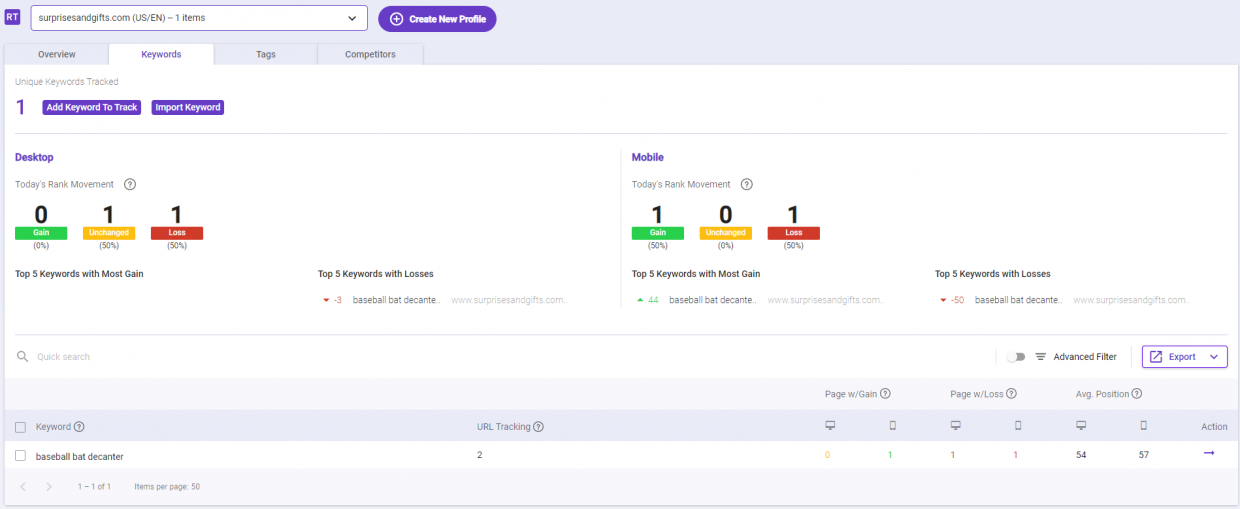
Below is the summary of all the keywords you are tracking. You can choose to view performance according to your preferred date.
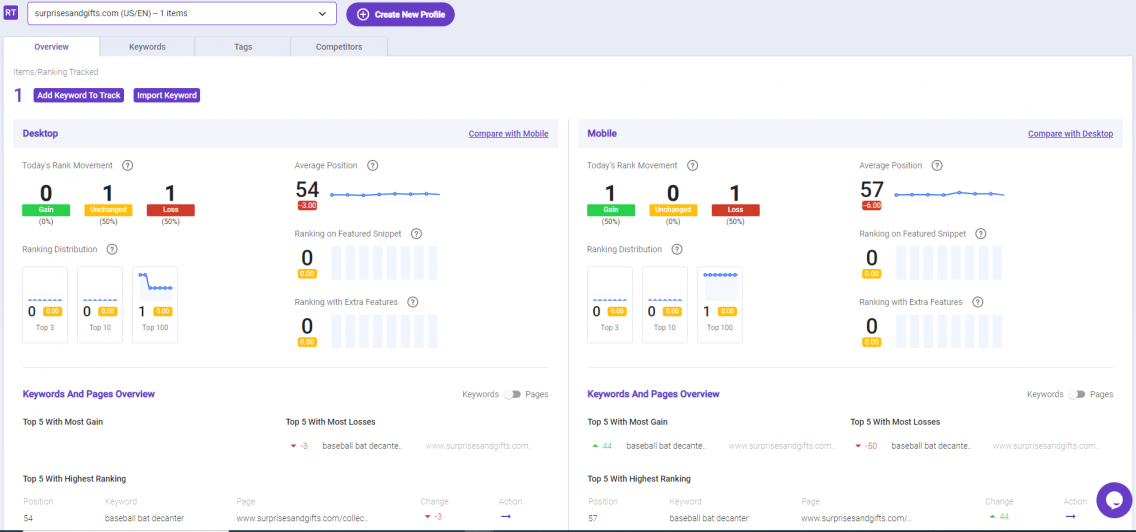
Tips: You can also check your competitor’s ranking performance by using Rank Tracking.
Site Traffic
Site traffic is one of the common indicators marketers use to check their content performance. Well, it is no surprise because traffic is the lifeblood of your content. No matter how great your content is, if nobody is reading them – it does not mean anything, really
That brings us to a pretty simple conclusion – traffic is one metric that you must measure.
After you are done with your content re-optimization, head over to your Google Analytics. These are the metrics that you may want to look at:
- Pageviews – the total number of times a page on your site has been viewed. Pageviews allow you to track how web traffic interacts with your site since it includes the total number of views.
- Unique pageviews – it combines the pageviews that are from the same person and just counts them as one. Unique pageviews show you a more accurate look at the amount of traffic coming to your website.

By using Google Analytics, you can further break down the data to see where your traffic is coming from, either geographically or how they found your site online. Just filter your traffic by ‘source/ medium’ if you want to see how your visitors managed to find you.
Knowing how you are discovered can be useful to plan your future content strategy. For example, if a large proportion of your traffic is coming from your social media channels, you may want to tailor your content to cater to that audience.
Engagement
It is insufficient just by using ‘traffic’ as your content performance indicator. Traffic can be easily manipulated with clickbait headlines. Here’s a clickbait headline from Buzzfeed you may not want to model yourself on:

Clickbait is one of the ways to boost clicks by creating an enticing mood yet often misleading readers. This tactic might bring a large number of visitors to your site, but they are highly likely to leave quickly too.
So, does that brief interaction do justice to your content performance? The short answer to that is ‘no’.
In fact, a high bounce rate would indicate that a site does not have the high-quality, relevant content that the search engine wants out of its top-ranked sites. If the content is not relevant to your visitors, then you can’t be expecting any conversion, sales, or leads too.
It is good to see high traffic visiting your site but isn’t it even more rewarding when these people actually interact with you?
I will have to say yes because traffic without engagement doesn’t contribute to my content’s goal.
After optimizing your content, check the bounce rate in your Google Analytics. Monitor if there are any significant changes over the next few days.
Conversion or…Sales, sales, and sales!
Now you have a number of visitors reading your content, but what do you want them to do next?
If we look into the definition for “conversion” in the MarketingSherpa glossary, it means:
“The point at which a recipient of a marketing message performs a desired action.”
In short, the conversion is simply getting someone to respond to your call to action.
If the goal of your content is to raise awareness of your brand and increase authority in your niche, you might want to take a look at the number of social shares and engagement.
On the other hand, if your content is aimed at selling a tool, you might want to track how many sales are generated after you’ve published them.
Traffic, engagement, and conversion are some of the indicators that can tell the performance of your content. There is no definite answer to what are the best metrics that you should use to check your content performance. You basically just want to use a metric to check if your content is performing better than yesterday.
This quote from Lord Kelvin totally blew my mind:
“If you can’t measure it, you can’t improve it.”
Conclusion
To sum it up, here are the five steps to conduct keyword gap analysis:
Step 1: Expand your target keyword
Step 2: Identify your competitors
Step 3: Identify the missing keywords
Step 4: Re-optimize your content
Step 5: Monitor and track your content performances
Don’t get me wrong, I’m not trying to say you can rank for “the benefits of exercising” on the search engine within the next 24 hours, but you can certainly grow your traffic in a reasonable time if you have put keyword gap analysis to good use.
Can you see how this applies to creating your next great content?
Try them out by first scanning the content that is not performing that well on your site. Choose that one lucky content to start with and monitor the results after you have done all the necessary steps.
Let me know in the comments below if you have done so!
Allow me to share another great quote from Arthur Ashe to end this article:
“Start where you are. Use what you have. Do what you can.”




